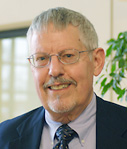To many people, psychology and mathematics seem to have little in common. But since the 19th century, math has played a crucial role in psychology and cognitive science.
In his inaugural lecture as the Clyde H. Coombs and J. E. Keith Smith Distinguished University Professor of Mathematical Psychology and Cognitive Science in LSA, David E. Meyer will discuss how math enhances the study of psychology. He will deliver the lecture “Mind, Mathematics and Machines: A Tribute to The Intellectual Legacy of Clyde H. Coombs and J. E. Keith Smith” at 4 p.m. Feb.1 in the Rackham Amphitheatre.
Distinguished University Professor is the highest professorial title granted at U-M. A reception will follow the lecture, which is free and open to the public.

Meyer, who is called “Dr. Motor Control” by some of his colleagues, is one of the researchers most responsible for developing rigorous theories of human movement planning. His work with David Kieras, a U-M computer scientist, has yielded deep understanding and precise computational models of human working memory, executive cognitive control and multi-tasking. In reporting on multi-tasking mania, news media often consult him about this cultural and technological phenomenon.
In his lecture, Meyer will discuss how mathematical and computational models can precisely describe how the human mind works. He will review examples from his research on the mental processes of cognition and action, honoring Coombs and Smith, former U-M professors of mathematical psychology. Meyer earned his doctorate in mathematical psychology from U-M in the 1960s, under their mentorship.
Coombs, who joined U-M after World War II, helped the field gain international prominence during the 1950s and ’60s. Smith — one of Coombs’ earliest graduate students — followed in his path to become chair of the U-M Department of Psychology in the 1970s.
Meyer pioneered research in cognitive science with his original theories and empirical work on the mental processes and brain mechanisms of the human mind, including perception, attention, learning, memory, action and complex cognition.
His first major breakthrough concerned semantic memory. Previously, a lack of theories and limited methodology had blocked advances in characterizing how people organize and access memorized information about word meanings, which is central to performing many cognitive tasks. Meyer introduced powerful new experimental procedures and theoretical models leading directly to creation of the “memory activation” research field. He also has illuminated other mental operations where information inputs are transformed to behavioral outputs during rapid task performance.
“Just like in physics and other natural sciences, lots of the best scientific psychology has involved applying various types of math, including the calculus, differential equations, modern algebra, probability theory, information theory and even algebraic geometry,” Meyer says. “Computational modeling, a modern off-spring of meta-mathematics, is also used in scientific psychology and cognitive science to formulate detailed theories of human mental processes.”
Meyer is chair of the Cognition and Cognitive Neuroscience Program in the Department of Psychology and director of the Brain, Cognition and Action Laboratory.
He is a member of the National Academy of Sciences and a fellow of the American Association for the Advancement of Science. The American Psychological Association has honored him with its Distinguished Scientific Contribution Award, and he has received the William James Fellow Award from the Association for Psychological Science in recognition of his lifetime contributions to basic research.
Meyer has participated on numerous journal editorial boards and review panels for the National Science Foundation, National Institute of Mental Health and U.S. Air Force. He also has served on the executive committee of the prestigious International Association for the Study of Attention and Performance. He joined the U-M faculty in 1977.

